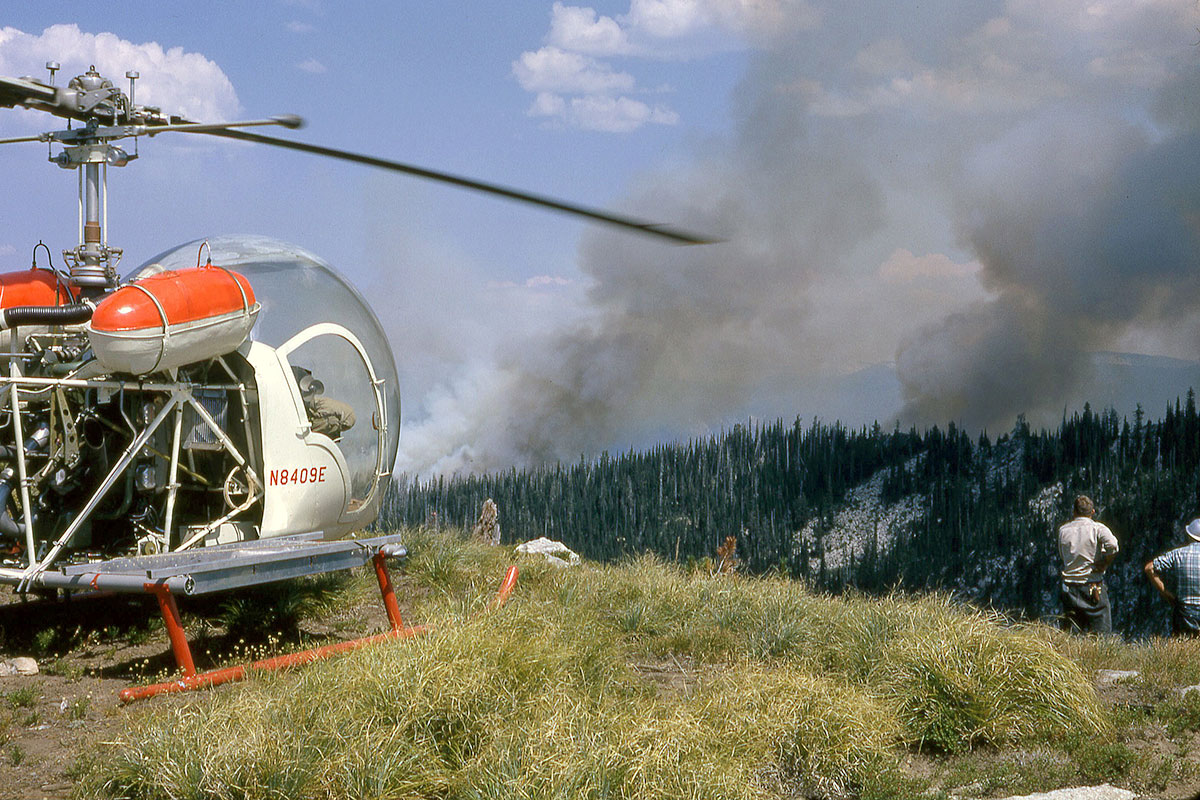Smokejumpers Recount Their Death-Defying Ordeal
Memories are seared in Dale Graff’s mind of fighting the Higgins Ridge wildland fire on August 4, 1961, as a young smokejumper doing his summer job during college.
“I never saw anything blow up so fast. It was the worst fire I’ve ever been on — like being inside a fiery tornado,” said the 86-year-old Helena resident of the fire in the Selway-Bitteroot Wilderness of northeastern Idaho.
He was among 12 smokejumpers recounting their death-defying odyssey in a recently aired PBS documentary, “Higgins Ridge.” It was the first time their story—a timeless example of fortitude, leadership, brotherhood, and heroism—had been told publically outside of smokejumper circles.
The fire burned so unbelievably hot that Graff said his plastic canteen cap melted. A friend burned his hand when he touched his hard hat. Swirling embers caught their pants on fire. His squad leader’s cloth covering around his canteen burned up. Wind of 50 to 60 miles per hour fanned the flames, creating its own weather system.
“Looking up, there was a convection column of smoke and flames, like a tornado,” Graff said. “Trees were exploding. It was a tough fire.”
For an hour, they sheltered in boulders and a semi-cleared helicopter landing area. Some put their face in holes they had dug, enabling them to breathe while suffocating smoke roiled above them. They poured water over their pants. Some wondered if they would become fatalities like the 13 firefighters who unsuccessfully attempted to outrun a fire in Mann Gulch near Helena on August 5, 1949. Applying lessons from the Mann Gulch tragedy, they remained in place.
A few hours earlier, the Higgins Ridge fire had started out routinely when 20 smokejumpers were dispatched to control a 2-acre blaze about 83 miles southwest of Missoula in Idaho’s Nez Perce National Forest. About mid-afternoon, an unexpected cold front blew in, creating a sudden inferno that grew to more than 6,000 acres.
“The fire was so loud, like a train,” Graff said. “We didn’t know what would happen to us. Then all of a sudden we saw a helicopter dropping down. We could hardly hear it over the fire. It was amazing to see.”
Helicopter pilot Rod Snider from Johnson Flying Services in Missoula and Bill Magnuson, a Moose Creek Forest Service ranger, had been looking for them for an hour. Refusing to give up, Snider had to refuel at a nearby ranger station before they were finally found at about 5:30 p.m.
In the documentary interview when Snider was asked why he took such a risk, he said, “You just can’t leave guys down in the position they were in. Oh, it had to be done. It had to be done.”
Graff also wondered why Snider risked his life.
“I later learned he was a smokejumper himself and then it made sense to me,” Graff said. “Only a smokejumper would have tried a rescue like that in those circumstances. There’s camaraderie, no matter where you’re based.”
Before becoming a helicopter pilot, Snider worked from the North Cascades Smokejumper Base from 1951 to 1953.
As Snider and Magnuson scanned the ground, through the thick smoke they saw the men’s orange fireproof Nomex shirts, newly issued that year.
Due to flames, wind, and smoke, Snider had to hover and descend and ascend vertically, straining the three-passenger Bell 47 G-3 single-engine light helicopter, with its bubble cockpit, exposed engine, and tail frame. He had named it Red Legs for the color of its landing skids.
“I was proud of that helicopter,” he said in the documentary interview about straining its cargo weight limit. “I felt good about getting them all out.”
Magnuson jumped out, and Snider began evacuating two passengers at a time, flying them to a nearby landing zone. As the fire intensified and his engine risked overheating, he realized he had to take more passengers with each run. He signaled for two men to ride on each skid in a basket along with two in the cockpit.
“I rode out in the basket,” Graff said. “There weren’t any belts or straps. You just held on.”
After six runs in a rescue effort that took more than two hours, all the men were safely evacuated by 8 p.m. Some were treated for smoke inhalation, burns, and minor injuries and were jumping again a week later.
“That summer of ’61was so busy,” said Graff, a smokejumper from 1960 to 1962. “We were paid $1.90 an hour straight time, and I made $2,500 that summer. That was a lot of money. In those three summers, I made 39 jumps with only one injury, a sprained ankle.”
Tom Kovalicky Nominates Pilot for Medal
Like Graff, Tom Kovalicky rode out in the skid basket.
“You just held on with your hands and feet and said Hail Mary,” said Kovalicky, 87, who lives in Grangeville, Idaho. “I saw Rod other times that summer when he had to fly out injured jumpers. He was humble, laid back, and dedicated to his job. He put people ahead of himself.”
He never forgot Snider, his airborne savior who lived in Boise, Idaho, and worked wherever he was assigned during fire seasons. A longtime Forest Service employee, Kovalicky nominated Snider for the North American Forest Service Medal. He was the 1976 recipient. He also received the Stanley-Hiller Pilot of the Year Award and the Carnegie Hero Fund Medal.
“Higgins Ridge was a remarkable event that went unnoticed until the documentary was done,” Kovalicky said. “I later found out at the time of the fire, an alternate press release had been written in case there were no survivors.”
The fire and Snider’s heroism and medal came to the attention of Lisa Tate, executive director of the National Museum of Forest Service History in Missoula. She and Rod were both avid hang gliders and met in Boise through mutual friends.
Wanting to preserve an oral history of the incident, in 2019 she coordinated with the University of Montana’s journalism department. At the time, Breanna McCabe was earning a master’s degree in environmental science and natural resource journalism. She embraced the project and assisted in recording the interviews in video format.
During the next three years, McCabe tracked down three additional Higgins Ridge survivors for interviews and compiled the smokejumpers’ original slides and archival footage to bring the story to life.
“Their stories were so extraordinary, so when I was hired at Montana PBS I was able to turn the footage into a documentary,” she said.
She said Snider downplayed being a hero and commented they were all heroes, the squad leaders who insisted the men follow protocol and remain in place as well as the smokejumpers for encouraging each other.
After that fateful summer, most of the Higgins Ridge smokejumpers never saw each other again until the National Museum of Forest Service History’s interview gathering event in 2019.
Public service careers
After surviving the Higgins Ridge fire, Graff and Kovalicky pursued public service careers.
Graff was hired as a game warden with the Montana Department of Fish, Wildlife and Parks. After a 31-year career, he retired as assistant chief in Helena.
Kovalicky worked for the U.S. Forest Service, retiring as superintendent of the Nez Perce National Forest from 1982 to 1991.
A memorial for Snider, who died May 4 at age 93, was held in Boise. ISI
Documentary interviews can be seen at higginsridge.org. Four of the 13 “Higgins Ridge” interviewees have since passed: Wade Erwin, Roger Siemens, John Holtet, and Rod Snider. Twelve of the 20 smokejumpers are still alive, including interviewees: Don Gordon, Dale Graff, Mark Greydanus, Roy Korkalo, Tom Kovalicky, Ross Parry, Bill Schroeder, James Van Vleck, and Neil Walstad.










